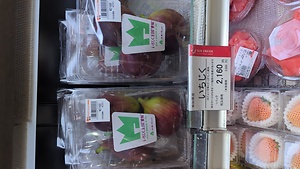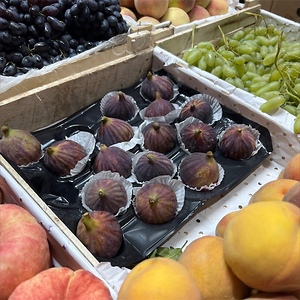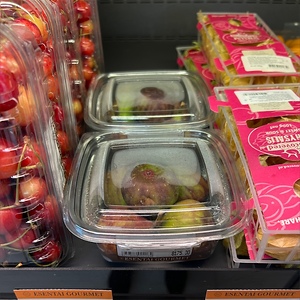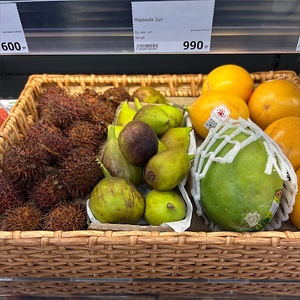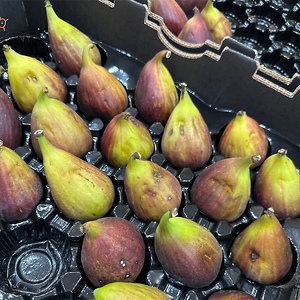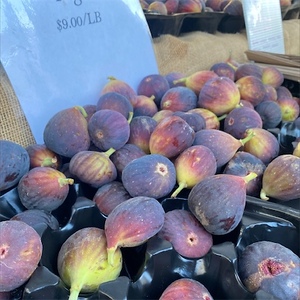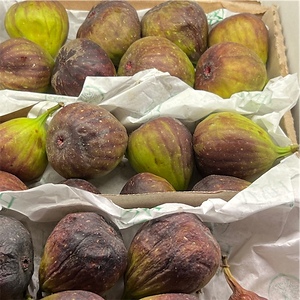

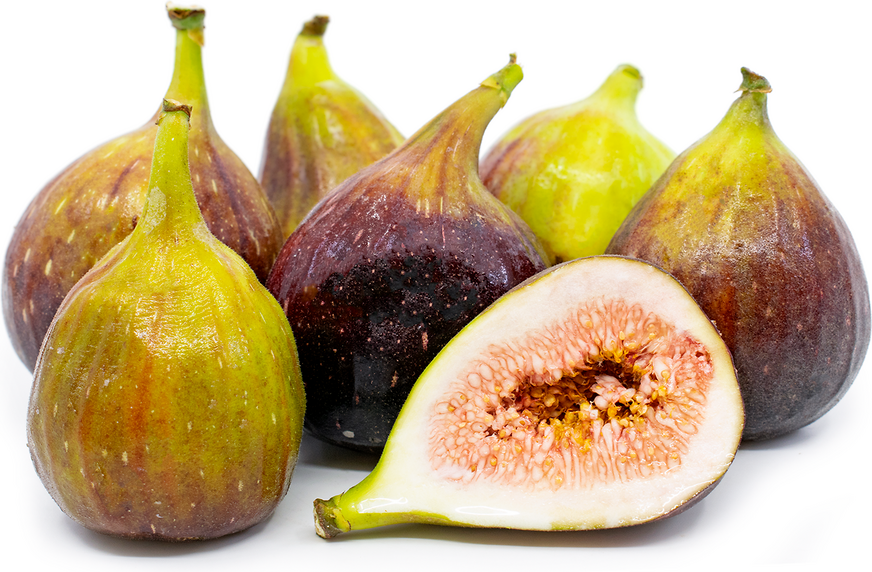
Brown Turkey Figs
Estimated Inventory, 3 lbs : 0
Description/Taste
Brown Turkey figs are a medium to large varietal, averaging 2 to 7 centimeters in diameter and 5 to 10 centimeters in length, and have an oblate, pyriform, to oblique shape, depending on the crop and season. The fruits may exhibit a thick, slightly curved neck or have no neck, and the base of the fruit is curved, tapering toward the stem end. Brown Turkey figs ripen from green to shades of dark purple, purple-brown, red-purple, to red-brown when ripe. The skin is ribbed, smooth, taut, and delicate, sometimes covered in tiny white spots. It is worth noting that there are different types of Brown Turkey figs, and some will have open eyes that have cracked during growth, while other eyes will remain semi-closed. Underneath the surface, a white layer of spongy, springy, soft tissue encases tiny seeds embedded into orange-pink flesh. The edible seeds provide a crunchy, chewy consistency contrasted with the sticky, jammy, and tender flesh. The flesh also features a small hollow cavity. Brown Turkey figs must be harvested ripe, as they do not ripen off the tree. Ripe figs are edible raw or cooked and have a mild, sweet, subtly nutty, and honeyed taste with soft, dried fruit and melon-like nuances.
Seasons/Availability
Brown Turkey figs are harvested over two seasons. The first crop, also known as the breba, is gathered from the late spring through early summer, while the second or main crop is picked from the late summer through early fall.
Current Facts
Brown Turkey fig, botanically classified as Ficus carica, is a category of large, hardy fig varieties belonging to the Moraceae family. The name Brown Turkey is extensively used for several types of figs grown worldwide that share similar growth characteristics, textures, and flavors, and market vendors often use the name in markets interchangeably as it is well-known. This general use of the name Brown Turkey has led to difficulty in distinguishing cultivars. Even within the Brown Turkey category, there are California Brown Turkey, Southern Brown Turkey, English Brown Turkey, Brown Naples, Long Naples, Aubique Noir, and La Perpetuelle figs, with many other names unlisted but used regionally. In general, Brown Turkey figs grow on deciduous shrubs to small trees, reaching 3 to 9 meters in height, and the figs have a long-ripening season, producing two seasonal crops. It takes Brown Turkey fig trees 3 to 5 years after planting to bear fruit, and the first crop, also known as the breba, develops the largest and mildest Brown Turkey figs as the plant’s roots have more access to water in the spring. The second crop, or the main crop, produces smaller, more concentrated fruits with a sweet taste, as the soil is typically drier in the late summer and fall. Brown Turkey figs are cultivated worldwide and are favored by growers for their productivity, ease of cultivation, fast-growing nature, and large figs. Most varieties of Brown Turkey figs are also self-pollinating, heat tolerant, and cold hardy. Worldwide, Brown Turkey fig trees are planted as ornamental landscape plants for their large leaves and silver-grey bark. The trees are also grown for their edible leaves and fruits. Despite their popularity, Brown Turkey figs are not commonly seen in commercial markets due to their highly perishable nature. The figs are primarily sold as a delicacy through select distributors or grown in home gardens.
Nutritional Value
Brown Turkey figs are a source of fiber to regulate the digestive tract, potassium to balance fluid levels within the body, vitamin C to boost the immune system, and vitamin A to maintain healthy organ functioning. The variety also provides copper to develop connective tissues, calcium to build strong bones and teeth, magnesium to control nerve functioning, iron to develop the protein hemoglobin for oxygen transport through the bloodstream, and other nutrients, including manganese, vitamin K, B vitamins, and phosphorous.
Applications
Brown Turkey figs have a sweet, mild, and slightly nutty taste suited for fresh and cooked preparations. The figs are primarily consumed raw worldwide and are valued for their soft, chewy, and tender consistency. Brown Turkey figs can be washed and used in any recipe calling for figs in general. The entire fig can be eaten and is popularly sliced into salads, used as a fresh topping over breakfast dishes, or served on charcuterie boards with cheeses. The flesh can also be spread over toast, wrapped in curried meats, or stuffed with various fillings. In addition to fresh preparations, Brown Turkey figs are simmered into jams, jellies, and preserves or added to sauces to complement roasted meats. The fruits can also be caramelized in honey and topped with goat cheese, baked and served over vanilla ice cream, or layered into sandwiches. Brown Turkey figs have a mild, sweet taste for scones, cakes, tarts, tiramisu, and ice cream, and their fruity flavor is used to balance savory dishes. Beyond the fruits, Brown Turkey fig leaves are dried and steeped as tea or used in the cooking process to impart smoky flavors. Brown Turkey figs pair well with herbs such as mint, lavender, and rosemary, citrus, honey, caramel, spices including cardamom, cinnamon, and pepper, and fruits such as raspberries, blueberries, pears, and peaches. Brown Turkey figs are highly perishable and should be immediately consumed for the best quality and flavor. Fresh, unwashed figs will keep for 3 to 7 days when stored in the refrigerator. Brown Turkey figs can also be frozen for up to six months.
Ethnic/Cultural Info
Brown Turkey figs were one of the fig varieties Thomas Jefferson grew at Monticello. The name Monticello translates to mean “Little Mountain” and was the primary home of the former President of the United States in Virginia. Jefferson resided at Monticello from 1770 to 1826 and constructed gardens as the centerpiece of his property. The gardens were home to fruit and vegetable gardens, orchards, and even a laboratory, where he conducted trials and experiments. It is said that Brown Turkey figs were one of the three main varieties Thomas Jefferson cultivated, along with Angelique and Marseilles figs. Jefferson meticulously recorded harvest dates for the varieties and planted the trees on the fig terrace, a south-facing spot in his garden below the kitchen garden. The fig terrace was a frequented spot when Jefferson hosted house tours, and the trees were highly productive, earning Jefferson the reputation of a successful fig grower. Historians believe Jefferson often referred to Brown Turkey figs as “purple figs” and planted them in his garden around 1817.
Geography/History
Figs are native to Western Asia and the Eastern Mediterranean regions and have been growing wild since ancient times. Historians believe figs to be one of the oldest cultivated fruits, and various texts, drawings, archeological sites, and records have contributed to uncovering their history. The origins of Brown Turkey figs are somewhat debated, as some experts claim they are native to Provence, France, while others say they have roots in Turkey. Regardless of its home site, Brown Turkey figs were spread throughout Europe and Asia as a favored fig for their hardiness and temperature tolerance. Spanish explorers carried figs to the New World sometime in the mid-16th century, and some of the first records of Brown Turkey figs in the United States were documented in the 19th century. W.B. West introduced Brown Turkey figs from Boston to California in 1853, and records of various nurseries across the United States have mentioned acquiring Brown Turkey Figs from England and other sources. After its introduction into the United States, Brown Turkey figs were selected for temperate climates and were bred to become self-pollinating, adapting the species into an easy home garden plant that could be grown independently. Today, Brown Turkey figs are found worldwide. The species is typically cultivated in drier climates, as humid air may cause the fruits to sour due to their semi-open eyes. Brown Turkey figs are seasonally found in local markets and through select distributors and retailers in Europe, Asia, Australia, and the Americas.
Recipe Ideas
Recipes that include Brown Turkey Figs. One
Podcasts



